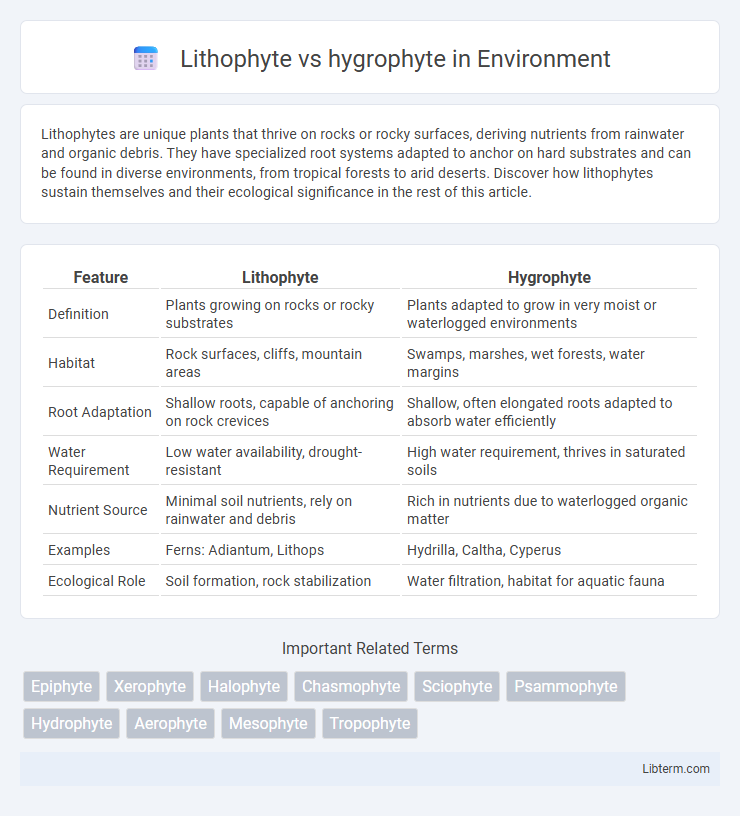Lithophytes are unique plants that thrive on rocks or rocky surfaces, deriving nutrients from rainwater and organic debris. They have specialized root systems adapted to anchor on hard substrates and can be found in diverse environments, from tropical forests to arid deserts. Discover how lithophytes sustain themselves and their ecological significance in the rest of this article.
Table of Comparison
| Feature | Lithophyte | Hygrophyte |
|---|---|---|
| Definition | Plants growing on rocks or rocky substrates | Plants adapted to grow in very moist or waterlogged environments |
| Habitat | Rock surfaces, cliffs, mountain areas | Swamps, marshes, wet forests, water margins |
| Root Adaptation | Shallow roots, capable of anchoring on rock crevices | Shallow, often elongated roots adapted to absorb water efficiently |
| Water Requirement | Low water availability, drought-resistant | High water requirement, thrives in saturated soils |
| Nutrient Source | Minimal soil nutrients, rely on rainwater and debris | Rich in nutrients due to waterlogged organic matter |
| Examples | Ferns: Adiantum, Lithops | Hydrilla, Caltha, Cyperus |
| Ecological Role | Soil formation, rock stabilization | Water filtration, habitat for aquatic fauna |
Introduction to Lithophytes and Hygrophytes
Lithophytes are plants adapted to grow on rocks or stony substrates, deriving nutrients from rainwater, air, and minimal organic matter on surfaces. Hygrophytes thrive in consistently moist or water-saturated environments, showcasing adaptations such as thin cuticles and large air spaces for efficient water uptake and gas exchange. Both groups exhibit specialized morphological and physiological traits to survive in their distinct ecological niches.
Key Characteristics of Lithophytes
Lithophytes are plants adapted to grow on rocky substrates, often exhibiting specialized root systems that anchor them securely while extracting limited nutrients and moisture from crevices. These plants typically possess thick, succulent leaves or reduced leaf surfaces to minimize water loss, enabling survival in harsh, nutrient-poor environments. In contrast, hygrophytes thrive in moist or aquatic habitats with abundant water availability, featuring thin leaves and extensive stomata to maximize gas exchange and transpiration.
Key Characteristics of Hygrophytes
Hygrophytes are plants adapted to thrive in environments with high moisture levels, featuring thin cuticles, large stomata, and extensive leaf surface areas to facilitate efficient transpiration and gas exchange. These plants possess well-developed aerenchyma tissues that aid in oxygen transport in water-saturated soils and typically exhibit shallow root systems optimized for wet habitats. In contrast, lithophytes grow on rocky substrates with limited soil and moisture, often displaying xerophytic adaptations for water conservation.
Habitat Preferences: Rocks vs. Wetlands
Lithophytes are plants adapted to grow on rocks, deriving nutrients from rainwater, dust, and minimal soil accumulation, often thriving in exposed, well-drained habitats with limited moisture. Hygrophytes prefer wetland environments such as swamps, marshes, and riverbanks, where high humidity and abundant water availability support their growth and physiological processes. The contrasting habitat preferences influence their root structures and water absorption strategies, with lithophytes having specialized adaptations for anchorage and drought tolerance, while hygrophytes possess features to manage excess water and oxygen availability.
Adaptations for Survival in Diverse Environments
Lithophytes exhibit adaptations such as specialized root systems for anchoring to rocky surfaces and efficient water absorption from minimal soil, enabling survival in nutrient-poor, dry environments. Hygrophytes possess large, thin leaves with abundant stomata and aerenchyma tissue to facilitate transpiration and gas exchange in consistently moist, water-rich habitats. These distinct physiological and structural traits allow lithophytes and hygrophytes to thrive in contrasting ecological niches by optimizing resource acquisition and stress tolerance.
Morphological Differences Between Lithophytes and Hygrophytes
Lithophytes exhibit thick, fleshy roots adapted for anchoring on rocks and absorbing minimal nutrients, while hygrophytes possess thin, extensive root systems designed for efficient water uptake in moist environments. Leaf morphology in lithophytes tends to be thicker and waxier to reduce water loss, whereas hygrophytes have broad, thin leaves with high surface area to maximize transpiration and gas exchange. Structural adaptations in lithophytes include reduced stomatal density for water conservation, contrasting with the abundant stomata in hygrophytes that facilitate rapid transpiration under high humidity conditions.
Examples of Common Lithophyte Species
Common lithophyte species include orchids like Dendrobium and Epidendrum, which grow on rocks in tropical regions, as well as ferns such as Asplenium and Selaginella that thrive on rocky surfaces. These plants have specialized root systems adapted to extract moisture and nutrients from minimal soil deposits or crevices in rocks. Lithophytes differ from hygrophytes, which are moisture-loving plants like ferns (e.g., Azolla) and mosses (e.g., Sphagnum) typically found in consistently wet environments.
Examples of Common Hygrophyte Species
Common hygrophyte species include ferns such as Adiantum (Maidenhair fern), mosses like Sphagnum, and aquatic plants such as Nymphaea (water lilies). These plants thrive in consistently moist environments, often found in wetlands, rainforests, and along riverbanks. Their adaptations enable efficient water absorption and retention, distinguishing them from lithophytes that grow on rocks and have minimal soil contact.
Ecological Roles and Importance
Lithophytes, plants growing on rocks, play a crucial role in soil formation by initiating the weathering process and providing habitats for microorganisms in nutrient-poor environments. Hygrophytes, adapted to thrive in moist or water-saturated habitats, contribute to maintaining water balance in ecosystems and support biodiversity by providing shelter and food for amphibians and invertebrates. Both plant types enhance ecosystem stability: lithophytes by stabilizing rocky substrates and hygrophytes by regulating hydrological cycles and preventing soil erosion.
Comparative Analysis: Lithophyte vs Hygrophyte
Lithophytes grow on rocks and exhibit adaptations like specialized root systems to extract nutrients and moisture from minimal soil, whereas hygrophytes thrive in consistently moist environments and possess features such as thin cuticles and large leaves to maximize water absorption and transpiration. Lithophytes display tolerance to drought and nutrient scarcity, while hygrophytes require abundant water for optimal physiological processes. These contrasting ecological niches reflect divergent evolutionary strategies for survival under variable moisture availability.
Lithophyte Infographic

 libterm.com
libterm.com